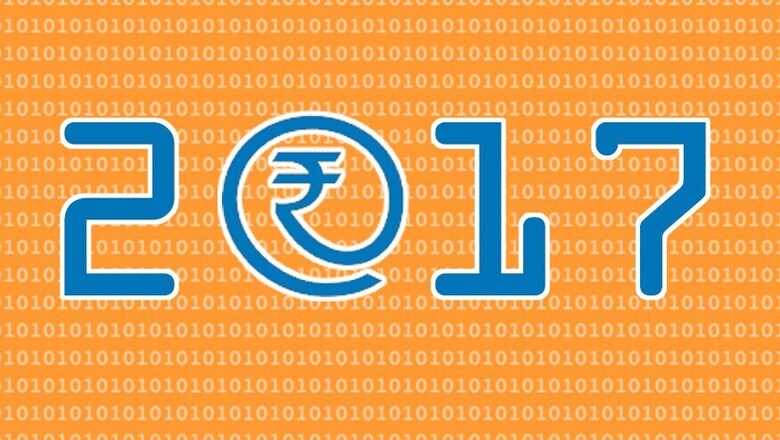
views

At the stroke of the midnight hour of December 31, the year 2016 will be demonetised and a new year, 2017, will come into currency. On the other side of the planet, another country will be bracing itself for the new most powerful man in the world.
The aftereffects of the biggest events of 2016 will be felt for years to come. Prime Minister Narendra Modi, by his November 8 announcement, pushed a surprised nation into a state of cashlessness.
Demonetisation, despite the argument over its merits, could very well be the biggest boost for digital India since the arrival of the internet in India, 21 years ago.
For Indians reading this, chances are you will be reaching out for your phone more frequently to make payments and the credit and debit cards in your wallet will show more signs of wear and tear than ever before.
From being a convenience, cashless transactions are becoming a necessity. This necessity will push more and more users into the digital fold.
For a large numbers of Indians the first introduction to the internet is no longer in a dingy cyber cafe, but on an inexpensive Android phone. This small rectangular screen is fast becoming the window to the world for Indians and, as a result of demonetisation, is also on its way to becoming the window to their wealth.
This forced digital initiation will add large numbers of new digital citizens, whose digital existence will benefit the government as well as businesses. It will also get inactive internet users to get online more frequently.
As a corollary this drive would also expose more of the weakest links in digital security to dark forces of the digital universe.
This mass digitisation of payments is not a natural progression but a forced one where millions of unsuspecting citizens have been pushed into an unprepared system.
Carrying cash involves the risk of physical theft, but distances are no deterrent for unauthorised access in a digital world.
A fourth of the country's population is not literate and "digital literacy is almost non-existent among more than 90% of India's population," according to the Digital Empowerment Foundation. Pushing for mass digital payments in a low-digital literacy environment poses a high security risk.
The weakest link in online security is usually the user. Lack of digital abilities and awareness makes users and their money even more vulnerable.
An awareness and readiness drive usually precedes any such large-scale campaign, but the idea of cashless - that has since morphed into less cash - appears to be an afterthought. There is no parallel security awareness blitzkrieg on a scale that matches the one for digital payment adoption.
Reliance Jio's entry has forced its competitors to lower data prices and this in conjunction with the effects of demonetisation will make it more attractive for Indians to go online. Also the government is already incentivising digital transactions.
However, this digital highway is full of potholes, that the government urgently needs to mend in 2017.
There are no laws in place that prescribe the minimum security standards that digital payment services need have in place. Also absent are regulations to protect user privacy and user data.
Data breaches have become commonplace. Some of the best known names in technology around the world have been affected by it. But India still doesn't have any strict regulatory enforcement regarding data breach disclosures.
Hackers are getting smarter and their attacks are hitting where it hurts the most. We are not really sure if the systems we have in place can withstand them.
Recently, information related to 32 lakh debit cards were reported to have been leaked affecting a number of banks. But the banks are not publicly talking about the breach. This not only highlights the need for financial institutions to secure data but also shows the obfuscation that the user has to face in such situations in India.
There could be many more breaches that haven't been revealed. There is an urgent need for India to have a data breach disclosure law.
Paytm, that has been at the forefront of the cashless campaign, till a few days ago didn't have a second layer of authentication to authorise payments. The new version of the app has included the feature, but it is still optional.
Users are generally known to choose convenience over security and therefore it is the responsibility of the government (and also the companies involved) to ensure that the user is forced to remain secure. Somewhat similar to the helmet and seat belt rules we have for driving bikes and cars on the road.
A malicious attack, say in the form of a DDoS (Distributed Denial of Service), can make digital payment systems inaccessible to the public in such strained times. It has happened to MasterCard and Visa in the past and can happen to any digital payment service provider again.
Digital, irrespective of the many claims, cannot kill cash any time soon. Unlike cash, cashless is not cross-platform. Point of Sale card swipe machines are not ubiquitous and many of them wouldn't accept certain kinds of cards.
As for mobile e-wallets, a retailer accepting Paytm might not accept FreeCharge and vice-versa. And as for the Universal Payment Interface, the usage and awareness of it is nowhere close to universal.
Much of the cashless transactions is dependent on internet connectivity, which is still patchy in many parts. The internet is also prone to disruptions because of forces of nature or executive actions (such as periodic banning of internet in Jammu & Kashmir and the North East). The internet-less USSD-based payment systems can come in handy but they the awareness about it is still low and there is a cost to the customer involved.
Cashless payments presuppose the possession of mobile phones and/or debit/credit cards, which is still a privilege for a large section of the population. The rural wireless teledensity in the country has just crossed the halfway mark.
Irrespective of the bottlenecks and the speed bumps, 2017 is going to be the year where more Indians will go digital than ever before. The government is appearing to do all that it takes to give demonetisation a semblance of success. This includes a heavy dose of digitisation.




















Comments
0 comment